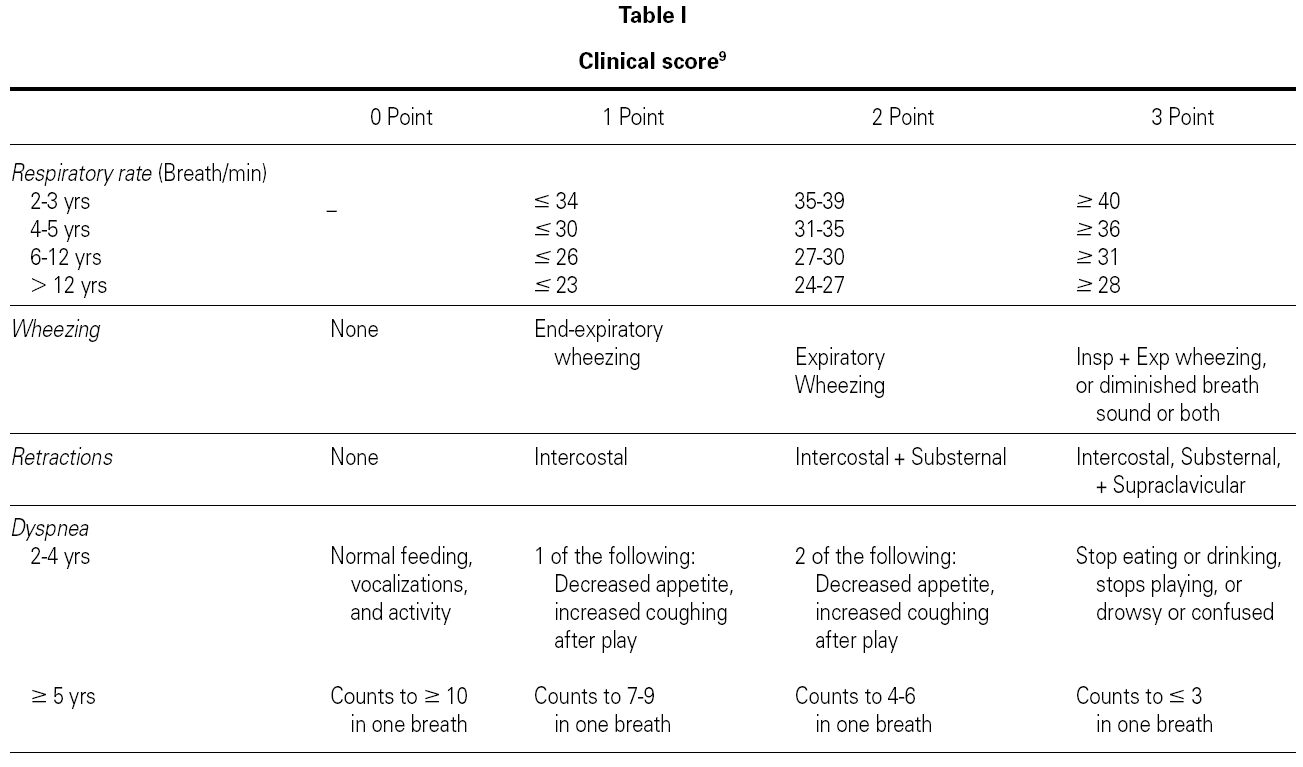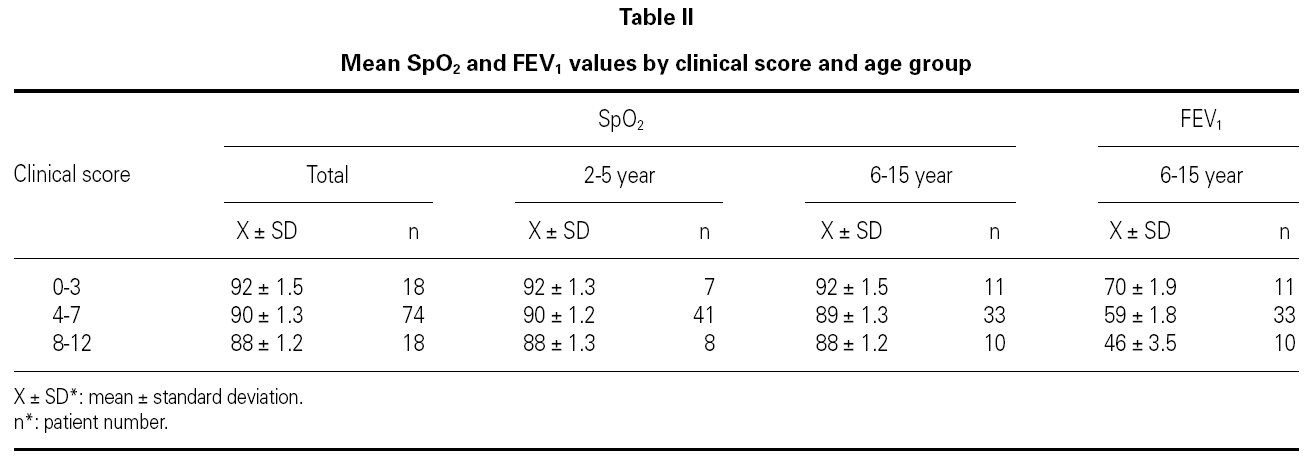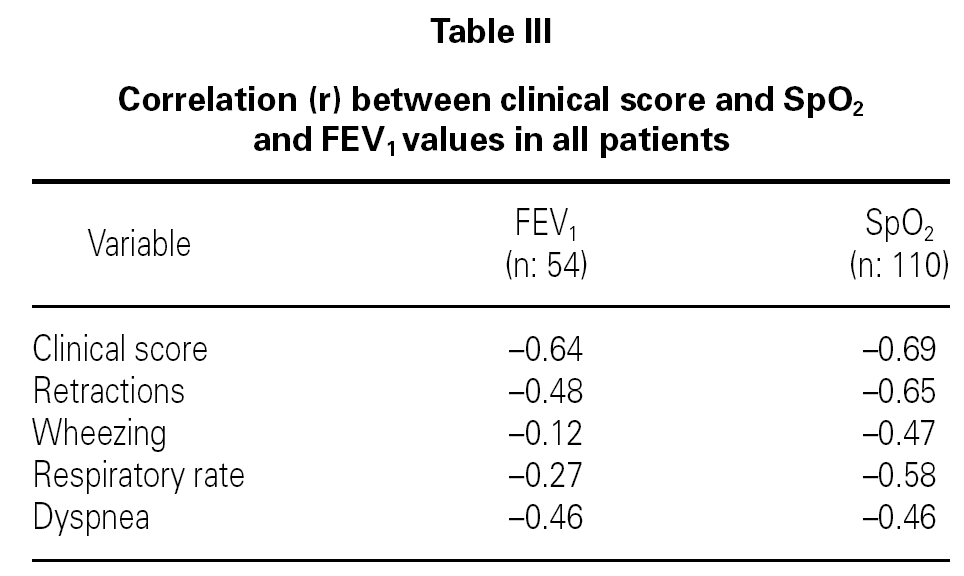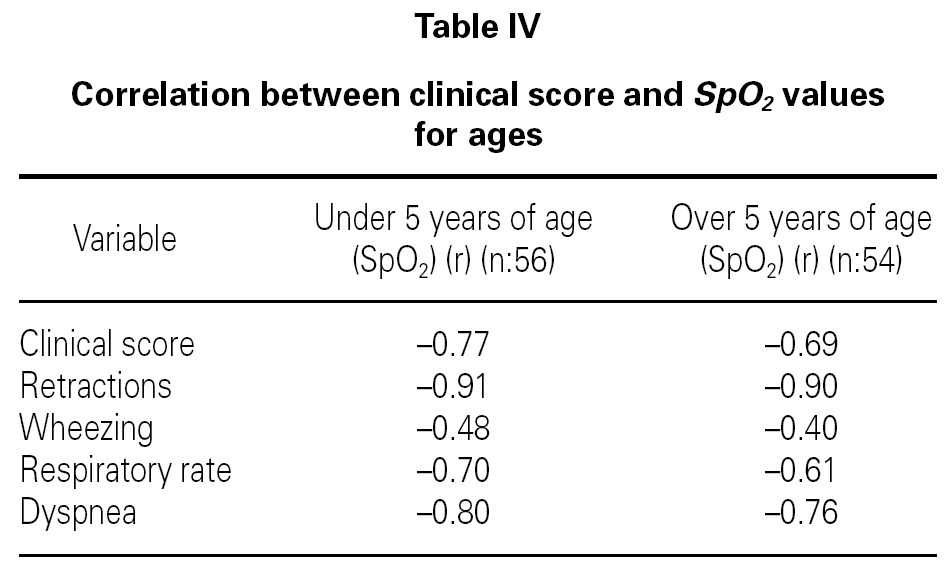INTRODUCTION
Acute asthma is the most common medical emergency in children and is responsible for increased hospitalization and death rates in several developing countries. In the emergency room setting, the most critical issue facing the attending physician is, deciding the adequacy of outpatient therapy of acute asthma, or when hospitalization is indicated. Traditionally, this decision is used to be made according to the clinical history, physical examination, laboratory results and response to therapy of the patient1-6. Several clinical scoring systems are presented for simplification of this. Among these some are not feasible as they contain parameters (pulsus paradoxus or inspiratory:expiratory ratio) which are difficult to be assessed by other personnel rather than the physician particularly in young children or those require active use of a monitoring device such as peak flow meter or oxygen saturation7,8. However, the clinical score we used is derived from the observation of physical signs by different care givers (physicians, nurses, respiratory therapists) in asthmatic children (table I)9.
Pulse oximetry on the other hand, is a widely used, noninvasive instrument for monitoring oxygen saturation. Its ease of performance has led to its widespread use in intensive care units and in the management of a variety of respiratory disorders7. Although obtaining spirometric test might be difficult in infants and young children who are excessively active, irritable, or uncooperative the forced expiratory volume in 1 sec (FEV1) correlates well with the severity of obstructive diseases in children over 5 years of age8.
The purpose of this study was to investigate the value of clinical signs in children with acute asthma and whether the information obtained would be of particular help to physicians who do not have ease of access to pulmonary function and oxygen saturation (SpO2) testing in the evaluation of such patients.
MATERIALS AND METHODS
We conducted a randomized double blind, observational study in 110 children (2-15 years of age) who were admitted to the Pediatric Emergency Room in more than one attack of acute bronchial asthma requiring bronchodilator therapy within 6 months of entry in the study. Children with a significant acute or chronic disease such as pneumonia, croup, pertussis, foreign body aspiration and cardiac congenital malformations were excluded. The study was approved by the Ethics Committee, and informed written consent from the parents was obtained.
The severity of acute asthma attack was evaluated by a physician using the clinical score which included respiratory rate, wheezing, dyspnea and retractions with the child standing, not crying, without fever and breathing room air only (table I)9. Simultaneously, a nurse, who was unaware of the patient's clinical score, measured SpO2 with a pulse oximeter (Kontron Minimon 7138 Plus) using a pediatric probe placed on the finger. The mean SpO2 was recorded after three measurements. Pulmonary function test (especially FEV1) with a spirometer (MIR, Sensor Medics 2130, USA) was only performed in children over 5 years of age. We recorded gender and age and measured height and weight of each children before spirometry. We have used Morris Polgar reference oxymetry values for height and weight.
Treatment was planned according to the emergency room asthma guidelines (GINA) and simply consisted of oxygen and steroid besides nebulized salbutamol10. We have also treated moderate and severe attack of asthma patients with oxygen, bronchodilator and steroid therapy. Patients were reevaluated at hourly intervals by the same clinical score, SpO2 and FEV1. The maximal duration of patients in the emergency room was 6 hours and all patients with a clinical score over 7 (n: 44) on admission needed hospitalization.
Data were analyzed by SPSS-10 program and the results were shown as mean and standard deviation (mean ± SD). The relation between the clinical score, FEV1 and SpO2 were assessed by Pearson correlation analysis and p < 0.05 was accepted as the significance level.
RESULTS
110 patients with acute asthma attack (66 male, 44 female) with a median age of 8 years (range 2-15 years) were included in the study. Mean clinical score was 6 ± 2 points, mean SpO2 value was 90 ± 2 %. FEV1 measurement was found to be 60 ± 12.3 % in patients 5 years and older (n: 54) (table II).
FEV1 measurement at presentation significantly correlated to the clinical score. Patients with clinical scores over 7 (severe clinical disease) had significantly lower FEV1 values. Disruption of pulmonary function most significantly correlated to the severity of retractions followed by the severity of dyspnea and wheezing whereas SpO2 value on presentation correlated most closely with the overall clinical score (table III, IV). All patients with a clinical score over 7 had a SpO2 value below 91 % however of the individual clinical variables, the most significant correlation was also between the retraction severities to SpO2.
Finally, a positive correlation was also found between SpO2 and FEV1 (r = 0.49, p < 0.001) most significantly in patients with SpO2 values below 91 %, and FEV1 value below 70 % that might indicate hypoxemia.
DISCUSSION
This study aimed to investigate the contribution of clinical evaluation in deciding hospitalization of children with acute asthma.
Previous studies demonstrated that there was no correlation between the clinical score of the children on presentation and the severity of hypoxia (r = 0.14)11,12. Meanwhile, many clinical scores have been developed to evaluate hospitalized children with asthma or bronchiolitis. The one that we have chosen is easy as it could be used either by a physician or a nonphysician provider9. Using this scoring system we found a significant correlation between the clinical score and FEV1 in this study. In adults and children, use of accessory respiratory muscles is reported to be the most important clinical sign and the best to correlate with the disease severity13,14. Our results also reveal that pulmonary function deterioration is found to be significantly correlated to the degree of accessory muscle use followed by the degree of dyspnea and wheezing. However, Becker et al7 showed a good correlation between pulmonary function testing and pulmonary index score which was 7.3 in patients requiring admission to the hospital. Kerem et al8 reported that patients who have accessory muscle use, wheezing and dyspnea had a negative correlation to FEV1 values that are found to be # 60 % of predicted. In spite of this strong correlation, measurement of FEV1 could not be helpful enough in very young, very ill or uncooperative patients besides in asthmatic children who had not previously had this test performed. On the other hand, as airway obstruction and hypoxemia could exist in the absence of clinical signs; pulmonary function tests must be used in conjunction with careful clinical evaluation.
This study depicted that a clinical score over 7 points had a sensitivity of 81 %, specifity of 100 % and positive predictive value of 100 % in diagnosing hypoxemia (SpO2 < 91 %). Although there is no definite value for defining hypoxemia according to SpO2 it is considered to be below 90-92 % in recent reports12,15,16.
There was also a significant correlation (r = 0.72; p < 0.0001) between the clinical score and SpO2 in our patients. Significant correlations between clinical score and SpO2 in patients under 5 years of age were similar to the patients over 5 years of age of whom spirometric tests were also performed (under 5 years r = 0.77, up to 5 years r = 0.69). At the end of two hours period in emergency room, 44 children required hospitalization and of these 36 were under 5 years old. Patients under 5 years of age often require hospitalization as a number of anatomic and physiologic variations of early life predispose to obstructive airway disease, the symptoms progress rapidly and noticed easily17. Patients who subsequently required admission to the hospital was found to have a mean clinical score greater than 7 and SpO2 lower than 91 % before the initial treatment in the emergency room in our study. Sole et al16 found a significant negative correlation between the clinical scores and SpO2 following emergency treatment. In addition, they showed that SpO2 levels # 92 % were associated with a 6.3-fold greater risk for requiring additional treatment. A single clinical finding will not be very indicative of severity of airway obstruction, but a combination of findings may provide more information to the first evaluation of acute asthma. Many studies showed that the clinical score could be more beneficial when it is taken as a whole, instead of evaluating each finding alone. Kerem et al8 also reported that all patients found to have a negative correlation between accessory muscle use, respiratory rate, dyspnea and SpO2 on presentation. Connett et al12 showed a good correlation (r = 0.37, p < 0.01) in 75 hospitalized asthmatic children (mean age 3.3 years; range 1.5-14.5 years) between the asthma severity score and SpO2 at the beginning of the treatment. They also demonstrated that a cut off value of SpO2 below 91 % in room air was a good predictor for hospitalization in children after pre and postnebulizer treatment of acute asthma.
Many developing countries do not have pulse oximetry and spirometry to determine the need to additional intensive unit therapy. We believe that clinical score is a valuable clinical tool that could easily be used by nursing and medical staff when these are not available.
In conclusion, although the use of clinical score should not replace laboratory evaluation such as determination of oxygen saturation and pulmonary function tests in an asthma attack, we recommend starting more intensive therapy and closer supervision after hospital admission in children with asthma attack who have a clinical score over 7 especially in developing countries with inadequate sources.
Correspondence:
Zühre Kaya
Birlik mahallesi 68. Sokak No: 18/4
06610 Çankaya. Ankara. Turkey.
Phone number: 90 0312 4954272
E-mail 1: kayaz74@mynet.com
E-mail 2: zuhrekaya@gazi.edu.tr












